
Pages:
<< Back 6
7 8
9 10
11 12
13 14
15
In
the meantime the development office under the leadership of President
Rosser and Vice President Bottoms had been successful in increasing
the level of annual giving to the university, especially through
the Annual Fund. In April 1983 Eugene L. Delves, chairman of the
board of trustees, announced the launching of a $90 million campaign
to be led by trustee James J. Kelly. Thirty months in the planning
stage, this drive, the most ambitious ever, was to reach completion
in June 1987 at the time of the celebration of the 150th anniversary
of DePauw University and was accordingly known as the Sesquicentennial
Campaign.
Unlike early campaigns which focused in large part on building projects,
this was aimed chiefly at raising funds to endow student scholarships
and academic programs. By February 1985 the campaign had made so
much progress that the goal was raised to $100 million. On Old Gold
Day the next fall the administration was able to announce that enough
gifts and commitments had been received to ensure going over the
new goal, but that the campaign would continue until its appointed
end in June 1987. It was said that no other liberal arts college
of DePauw's size had ever raised so large a sum in a single campaign.
Gifts from alumni accounted for nearly 85% of the total. 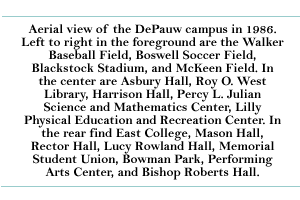
Among the immediate results of the campaign was the establishment
of the Fisher Fund for faculty development and scholarly research,
funded by a gift in excess of $1 million from John and Janice Fisher
of Muncie, Indiana. In February 1985 the administration revealed
that anonymous donors had made a multimillion dollar donation to
the university for the creation of a Center for Contemporary Media.
President Rosser, who described the gift as the largest in the history
of the university, appointed a committee to plan for the establishment
of the center, which would include resources for training undergraduates
in radio, television, and print journalism within a liberal arts
context. Named to head the center was Drake Mabry from the Des Moines
Register, who set up headquarters in the former Delta Zeta sorority
house on East Anderson Street.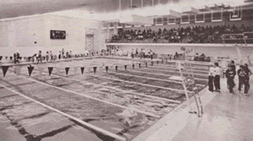

The
Rosser administration faced continuing demands from the student
body for increased autonomy in personal and social affairs. The
visitation issue was finally resolved in 1978 by a plan offering
all students certain visitation options for members of the opposite
sex. Incoming freshman were assigned to rooms in university residences
according to their stated preferences on this matter, and visitation
procedures for sections of upperclass halls and Greek living units
were to be determined by 3/4 vote of the residents. In the fall
of 1979 an additional option was provided by making both Longden
and Hogate Halls coeducational, with men and women living on alternate
floors. In addition juniors and seniors could obtain permission
on a lottery basis to live out in town, the number not to exceed
four percent of the undergraduate student body.
 ______________________________________
______________________________________
Varsity basketball game in the new
Neal Fieldhouse
in 1984, the year that DePauw advanced to the
final
four in the NCAA tournament in
Grand Rapids, Michigan.
_______________________________________
For
the first time all students were permitted to bring automobiles
to campus, with the proviso that they register them with the Student
Affairs Office and park them only in university-designated areas.
The thorniest question of all was the drinking issue, long the subject
of student agitation and administrative concern. By 1980, however,
the administration, recognizing a significant shift in attitudes
among the DePauw constituency, was ready to make an historic departure
from the traditional policy of prohibition by according students
over the legal age the right to consume alcoholic beverages under
certain conditions. Discussions over the next four years culminated
in the adoption in 1984 by the board of trustees of a new comprehensive
policy "intended to promote either abstinence or responsible
use of alcohol." Strict guidelines and regulations were set
down concerning the serving and consumption of alcoholic beverages
by students that included a complete compliance with the laws of
Indiana. The administration also demonstrated its special concern
in the area of alcohol abuse and reaffirmed its opposition to the
possession, use, or sale of illicit drugs.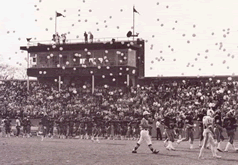
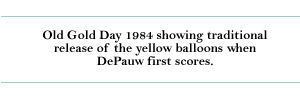
A
large number of new instructors joined the ranks of the faculty.
Listed below by departments, they include the following: art: Robert
D. Kingsley and Catherine Fruhan; biological sciences: Robert J.
Stark, Wade N. Hazel, Bruce S. Serlin, and Kathleen S. Jagger; chemistry:A.J.C.L.
Hogarth, Bryan S. Hanson, and David T. Harvey; classical studies:
Carl A. Huffman; communication arts and sciences: Nancy J. Metzger,
Samuel Abel, and Jeffrey N. McCall; economics and management: Anthony
V. Catanese, Margaret E. Catanese, William J. Field, Shanker Shetty,
Daniel R. Wachter, Wassim N. Shahin, and Lisa L. Wichser; English:
Martha Rainbolt, Wayne E. Glausser, J. David Field, Istvan Csicery-Ronay,
David Klooster, and Erin McGraw; geology and geography: Frederick
M. Soster; health, physical education and recreation: Nick Mourouzis
and Michael Steele; history: Barbara J. Steinson, John T. Schlotterbeck,
Sharon Nolte, and John Dittmer; mathematics and computer science:
Richard C. Smock, Gloria C. Townsend, Janet E. Teegarden, Susan
C. Gardsbane, Mark Kannowski, Nachimuthu Manickam, Robert Hieb,
and Steven Csik.
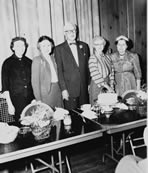 
Other additions include, also by department: philosophy and religion:
John B. White, Marthe A. Chandler, William P. Harmon and Naomi Steinberg;
physics and astronomy: Howard L. Brooks and Victor A. DeCarlo, Jr.;
political science: Sidney M. Milkis, Ngeen Sang-Mpam, James R. Simmons,
and Bruce Stinebrickner; psychology: Candace J. Schulenberg, Steven
R. Raines, Thomas E. Hagaman, and Donald Haruo Ryujin; Romance languages:
Francoise M. Coulont-Henderson and Arthur B. Evans; sociology and
anthropology: Deborah P. Bhattacharyya, Nancy J. Davis, and Darrell
E. La Lone.
The School of Music: Vergene C. Miller, Randy K. Salman; Dan
J. Rizner, David L. Ott, and Cleveland T. Johnson; the School of
Nursing: Sherry Smith, who became director of the school in 1979;
Martha S. Avery, Carol L. Cherry, Theresa A. Kessler, Anna M. Miller,
Margaret S. Hamilton, Louise Hart, and Nancy Drew. Directors of
the quantitative reasoning center, the writing center, and the speaking
and listening center were Susan Gardsbane, David Klooster, and Ann
Weiss, respectively. Added to the library staff in this period were
Loraine N. Sprague, Pei-Ling Wu, Gillian S. Gremmels, and Kathy
Davis. Upon the retirement of James Martindale in 1983, Jana Bradley
was named director of libraries. The next year Wesley W. Wilson
became coordinator of archives and special services.
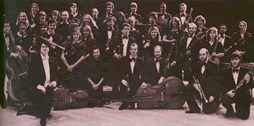
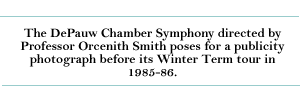
President Rosser was granted a sabbatical leave for travel and writing
the first semester of the 1985-86 academic year, during which Vice
President Bottoms took charge of university operations. Shortly
after Rosser's return to campus in January 1986 he announced his
intention to resign the presidency in July. The Board of trustees
then appointed him to the post of chancellor of the university with
responsibilities primarily for external relations and coordination
of the upcoming celebration of DePauw's 150th anniversary. In September,
however, Chancellor Rosser resigned from the university in order
to accept the presidency of the National Association of Independent
Colleges and Universities. He went to Washington, D. C. to take
up his new duties and soon moved with his wife Donna Eyssen Rosser
to a new home in Alexandria, Virginia.
Within a few weeks of Rosser's resignation from the presidency,
the board of trustees named Vice President Robert G. Bottoms as
his successor, making the appointment from the current faculty and
administrative ranks for the first time since the elevation of Dean
Hillary Gobin to the presidency in 1896. The new president was a
native of Alabama who had earned a B.A. from Birmingham-Southern
College, a B.D. from Emory University, and the degree of doctor
of ministry from Vanderbilt University. He served as assistant dean
and assistant professor of church and ministry at Vanderbilt before
coming to DePauw in 1978. A member of St. Andrews Episcopal Church
in Greencastle, he became the first non-Methodist president of DePauw
University.
Back
to Top
Pages:
<< Back 6
7 8
9 10
11 12
13 14
15
|





 ______________________________________
______________________________________




